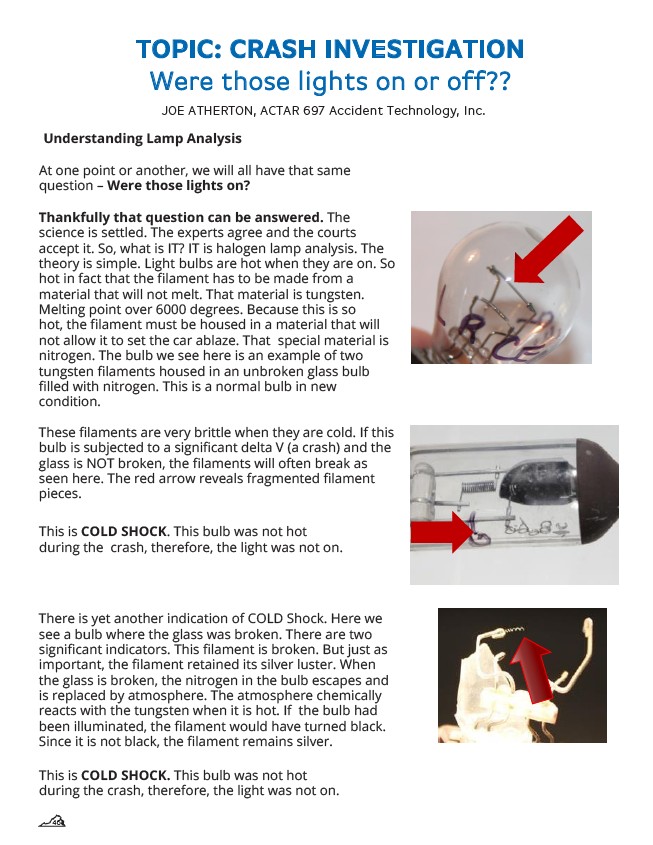
TOPIC: CRASH INVESTIGATION
Were those lights on or off??
JOE ATHERTON, ACTAR 697 Accident Technology, Inc.
Understanding Lamp Analysis
At one point or another, we will all have that same
question – Were those lights on?
Thankfully that question can be answered. The
science is settled. The experts agree and the courts
accept it. So, what is IT? IT is halogen lamp analysis. The
theory is simple. Light bulbs are hot when they are on. So
hot in fact that the filament has to be made from a
material that will not melt. That material is tungsten.
Melting point over 6000 degrees. Because this is so
hot, the filament must be housed in a material that will
not allow it to set the car ablaze. That special material is
nitrogen. The bulb we see here is an example of two
tungsten filaments housed in an unbroken glass bulb
filled with nitrogen. This is a normal bulb in new
condition.
These filaments are very brittle when they are cold. If this
bulb is subjected to a significant delta V (a crash) and the
glass is NOT broken, the filaments will often break as
seen here. The red arrow reveals fragmented filament
pieces.
This is COLD SHOCK. This bulb was not hot
during the crash, therefore, the light was not on.
There is yet another indication of COLD Shock. Here we
see a bulb where the glass was broken. There are two
significant indicators. This filament is broken. But just as
important, the filament retained its silver luster. When
the glass is broken, the nitrogen in the bulb escapes and
is replaced by atmosphere. The atmosphere chemically
reacts with the tungsten when it is hot. If the bulb had
been illuminated, the filament would have turned black.
Since it is not black, the filament remains silver.
This is COLD SHOCK. This bulb was not hot
during the crash, therefore, the light was not on.
46
TOPIC: CRASH INVESTIGATION
Were those lights on or off??
JOE ATHERTON, ACTAR 697 Accident Technology, Inc.
Understanding Lamp Analysis
At one point or another, we will all have that same
question – Were those lights on?
Thankfully that question can be answered. The
science is settled. The experts agree and the courts
accept it. So, what is IT? IT is halogen lamp analysis. The
theory is simple. Light bulbs are hot when they are on. So
hot in fact that the filament has to be made from a
material that will not melt. That material is tungsten.
Melting point over 6000 degrees. Because this is so
hot, the filament must be housed in a material that will
not allow it to set the car ablaze. That special material is
nitrogen. The bulb we see here is an example of two
tungsten filaments housed in an unbroken glass bulb
filled with nitrogen. This is a normal bulb in new
condition.
These filaments are very brittle when they are cold. If this
bulb is subjected to a significant delta V (a crash) and the
glass is NOT broken, the filaments will often break as
seen here. The red arrow reveals fragmented filament
pieces.
This is COLD SHOCK. This bulb was not hot
during the crash, therefore, the light was not on.
There is yet another indication of COLD Shock. Here we
see a bulb where the glass was broken. There are two
significant indicators. This filament is broken. But just as
important, the filament retained its silver luster. When
the glass is broken, the nitrogen in the bulb escapes and
is replaced by atmosphere. The atmosphere chemically
reacts with the tungsten when it is hot. If the bulb had
been illuminated, the filament would have turned black.
Since it is not black, the filament remains silver.
This is COLD SHOCK. This bulb was not hot
during the crash, therefore, the light was not on.